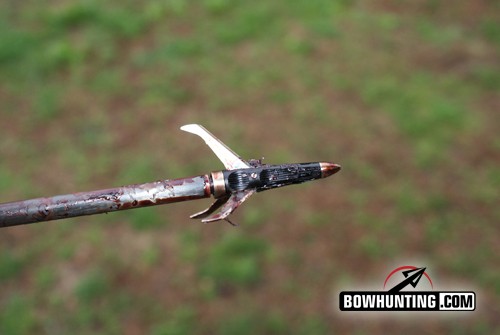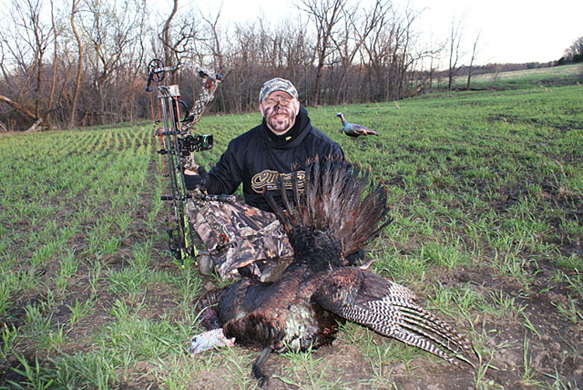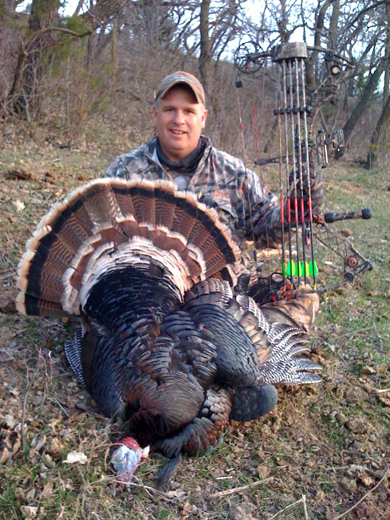LAST UPDATED: May 1st, 2015
If you are considering bowhunting turkeys this spring, realize, if you don’t already, that bowhunting turkeys is extremely challenging. It isn’t challenging because turkeys are tough to hunt. Let’s face it: for the most part getting within bow range of a trophy gobbler is much easier than getting within bow range of a trophy buck. The tough thing about killing a turkey with archery tackle is recovering the bird. Turkeys will often run and hide after you shoot them. They will hide under brush, in a pile of leaves or worse yet: fly away and die a mile from where you shot them. If you can reduce the possibility of the bird running or flying off, you greatly increase your chances of eating turkey pot pie one day very soon.
When hunting whitetails you have to be somewhat conservative with cutting diameter and penetration. Not so when it comes to bowhunting turkeys. The key is to immobilize the bird using the largest cutting diameter broadhead you can find—-this usually means mechanicals such as the NAP Gobbler Getter (pictured here).
Broadhead Options
To increase your odds, I suggest that you use a mechanical broadhead. Mechanical broadheads are a turkey hunters’ dream come true and a turkey’s worst nightmare. When most of us choose new mechanical heads, we often choose a head that offers a large cutting diameter but not too large to cause penetration problems. When choosing a broadhead for turkey hunting, buy a broadhead with an extremely large cutting diameter. Many companies make mechanical heads with 2-1/4-inch or larger cutting diameter. Shooting those at a turkey is like shoving a softball through their vitals. Often there isn’t much left of the vitals after the kill. (preparing for turkeys)
While turkeys can be tough, they are even tougher to find if they are allowed to stay on their feet, or worse, get into the air. Once they have been shot and are still on the ground, don’t hesitate to run over and finish off your bird or keep him grounded until he dies. Bowhunting.com Senior Editor Steve Flores did just that on this Kansas longbeard a few seasons back.
Aiming Options
One reason using a large head is important is because the vitals on a turkey are fairly small: about the size of a softball. If your aim is true, the turkey doesn’t go far and they die quickly. If your aim is off slightly, there is a good chance you will miss the vitals and only wound the bird. It runs off and hides and you go home to cry in your soup. With a large mechanical head, even if your aim is off there is a good chance you will still slice the vitals and kill the bird. (turkey vitals)
Mathews Archery’s Joel Maxfield shared his opinion with the author on the best place to shoot a turkey. His track record speaks for itself.
Many bowhunters will tell you to aim for the head, the butt of the wing, or the back end of the bird. Few people kill as many birds with a bow as Joel Maxfield from Mathews Archery (more Mathews info). Joel taught me many years ago that if you want to quickly immobilize a turkey and kill him, shoot him right above the legs. “If you take out a turkey’s legs, he can’t run or fly away,” Maxfield said. “I aim right above the legs. It takes out the back end of their vitals and it breaks all the tendons going to the legs. Most of the time, they fall over and die right there. If they walk, it usually isn’t far.” (watch Turkey Hunts)
If you are thinking about chasing the monarch of spring with a stick and string this spring, get the largest mechanical head you can buy and shoot them above the drumsticks. Could someone please pass the gravy?
Editor’s Note: Tracy Breen has been diagnosed with cerebral palsy and often writes and speaks about overcoming physical challenges in order to enjoy the outdoors. At 34 years of age, Tracy is one of the youngest full-time outdoor writers in America. Learn more about Tracy and his hunting adventures at tracybreen.com.

 By
By 






